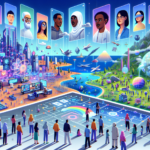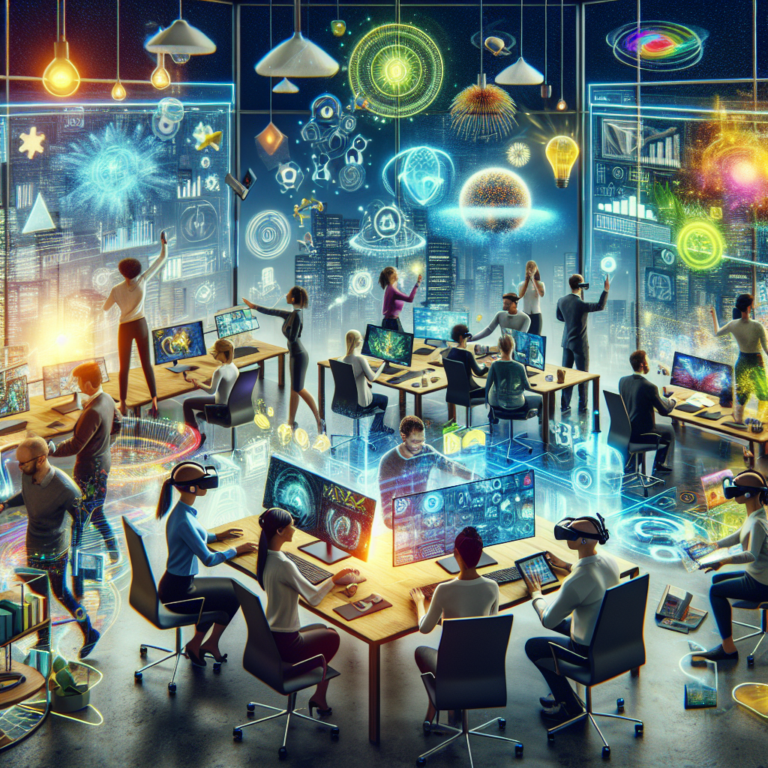The Future is Here: How XR is Revolutionizing Collaborative Workspaces 🌐
XR Collaboration : What It Is and Why It Matters
In the fast-paced world of business, where remote work and globalization have become the norm, the need for innovative solutions to enhance collaboration is critical. Enter Extended Reality (XR) — a collective term that encompasses **Virtual Reality (VR)**, **Augmented Reality (AR)**, and **Mixed Reality (MR)**. XR technology is bridging distances in business by creating immersive environments that transform the way teams interact and collaborate.
The Rise of Collaborative Workspaces
As organizations shift towards remote work and flexible office setups, traditional workspaces are evolving. Collaborative workspaces are designed to foster teamwork, innovation, and engagement — crucial elements in driving productivity. With the integration of XR, these workspaces can now extend beyond physical boundaries, enabling employees from various locations to work together seamlessly.
XR Collaboration : Breaking Barriers with XR Technology
One of the most exciting aspects of XR is its ability to break down barriers in communication and collaboration. Through immersive experiences, team members can engage as if they were in the same room. Here are some of the key benefits XR brings to collaborative workspaces:
- Enhanced Communication: XR tools replicate in-person interactions, allowing for more natural dialogues and non-verbal cues.
- Increased Engagement: Interactive experiences keep participants engaged, making meetings more productive and enjoyable.
- Realistic Simulations: XR enables teams to simulate real-world scenarios, perfect for training or brainstorming sessions.
- Cost-Efficiency: Virtual meetings save on travel expenses and allow organizations to invest resources elsewhere.
Transforming Brainstorming into an Immersive Experience 🎨
Gone are the days of dull PowerPoint presentations. With XR, brainstorming sessions become dynamic and engaging. Imagine collaborating on a project in a virtual environment where ideas can be modeled in 3D, allowing team members to interact with them in real-time.
The Power of Virtual Reality in Team Meetings
Virtual reality is taking the concept of meetings to another level. Here’s how VR can transform your team meetings:
- Interactive Presentations: Use VR to create interactive presentations, engaging your audience and making information retention easier.
- Virtual Environments: Host meetings in stunning virtual landscapes or custom-designed environments that inspire creativity and focus.
- Global Accessibility: Include team members from across the globe without the need for expensive travel, all while ensuring they feel part of the discussion.
Augmented Reality: Enhancing Real-World Interactions
While VR creates entirely virtual environments, Augmented Reality superimposes digital information onto the real world. This innovation is making its way into collaborative workspaces, enhancing how teams interact even when they are physically apart.
Real-Time Collaboration with Augmented Reality
AR technology allows remote team members to share insights and ideas instantly. Here’s how it boosts collaboration:
- Overlaying Data: Team members can overlay charts, graphs, or notes on physical documents during meetings, ensuring everyone is on the same page.
- Live Annotations: Use AR for live annotations during discussions, helping to clarify points and encourage collaboration.
- Interactive Models: Designers can project 3D models into real-world settings, allowing for better visualization and feedback from teams.
The Role of Mixed Reality: Bridging Both Worlds
Mixed Reality takes the best of both VR and AR, allowing users to interact with both physical and digital elements. This seamless blending of worlds is particularly transformative in collaborative workspaces.
Pioneering New Approaches to Problem-Solving
Mixed Reality can be a game-changer for problem-solving in teams. Here’s how:
- Collaborative Platforms: Utilize MR platforms where team members can interact with both physical and virtual elements, increasing the depth of the discussion.
- Scenario Planning: Create and manipulate multi-layered scenarios, allowing teams to explore potential outcomes and solutions in real-time.
- Spatial Awareness: By combining physical and digital spaces, team members can better understand complex projects and workflows.
The Future of Workplace Collaboration with XR
As technology continues to evolve, XR will certainly play a significant role in shaping collaborative workspaces. The potential of these tools extends far beyond basic communication; they empower businesses to innovate, engage, and collaborate like never before.
Building a Future-Ready Workforce
Integrating XR technology into your collaborative workspace not only enhances communication but also helps in building a future-ready workforce. Here’s what businesses stand to gain:
- Skill Development: Training programs using XR can accelerate learning, making new employees productive more quickly.
- Adaptability: Employees become accustomed to using cutting-edge technology, preparing them for future advancements.
- Retention Rates: Innovative tools make workplaces more attractive to new talent, contributing to higher retention rates.
Embracing the Change: How to Get Started with XR
To harness the power of XR in your business, consider the following steps:
- Assess Your Needs: Identify areas where collaboration could improve and determine how XR can address these gaps.
- Invest in Technology: Commit to investing in reliable XR solutions that align with your business objectives.
- Train Your Team: Provide your employees with the necessary training to use XR tools effectively.
XR is no longer a concept of the future; it is a necessary component of modern business collaboration. Whether through VR, AR, or MR, the potential for bridging distances and enhancing collaborative workspaces is tremendous. Embrace the change, and watch your organization soar to new heights! 🚀




0 Comments